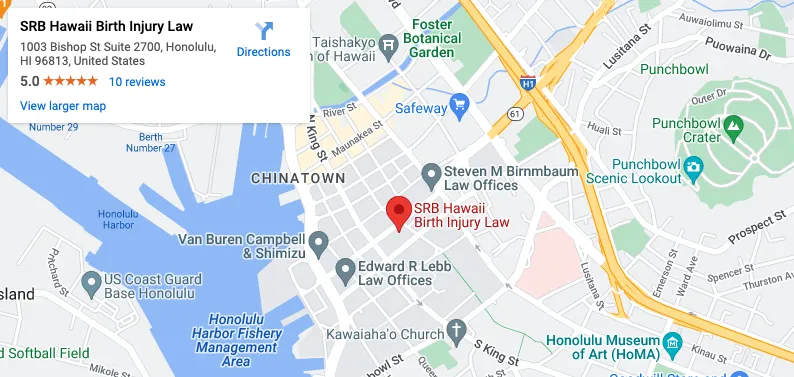Forceps Delivery Injury Lawyers in Honolulu, Hawaii
Most birth injuries are minor and treatable with the proper monitoring and treatment. Still, birth injuries are not rare. Forceps delivery should only be used in a fetal crisis or prolonged labor when the baby cannot readily pass through the birth canal since they increase the risk of trauma and problems.
Call SRB Hawaii Law to arrange a free case evaluation to review your family’s legal rights concerning your baby’s avoidable birth trauma brought on by medical malpractice. Our talented Honolulu forceps delivery injury lawyers will review your sensitive information and fight for justice on your behalf.
Forceps or vacuum extraction must be used with caution by an obstetrician. A serious birth injury can be brought on by the improper use of forceps during an acute delivery process. Regardless of how the medical professional portrays it, using forceps is challenging.
Why do you need an attorney for forceps delivery complications?
It might be challenging to file a medical malpractice lawsuit for a forceps delivery injury without the assistance of our forceps delivery injury lawyers. Your doctor or any medical professional who attended your delivery may have impacted your or your baby’s current health.
We can assist you in:
- Determining fault,
- Showing that the medical professional fell short of the required level of care, and
- Determining the damages you may be entitled to.
These damages could result in a sizable cash recovery once they are established. Discuss your case with one of our skilled Birth Injury Lawyer in Honolulu immediately to get started on the path to physical and financial recovery.
What Are the Common Types of Forceps Delivery?
Depending on where the baby’s head is in the birth canal, there are four possible forceps classifications:

Outlet Forceps Delivery
When the baby’s head is visible between contractions without parting the labia and has reached the pelvic floor, an outlet forceps delivery takes place.
Low Forceps Delivery
A low forceps delivery is necessary when the baby’s head is at or below +2 station but has not yet contacted the pelvic floor.
Mid-Forceps Delivery
A mid-forceps delivery occurs when the baby’s head is engaged in the mother’s pelvis but is above +2 station. Several residency programs in the United States no longer need competency in mid-forceps delivery. Contrary to challenging mid-forceps delivery, a C-section is frequently advised.
High Forceps Delivery
In contemporary obstetrics, high forceps deliveries are no longer performed. The baby’s head was not engaged in the pelvis during this delivery. Nowadays, a C-section is the usual delivery method in this situation.
What are the different indications for forceps use?
Reasons to use forceps include avoiding C-sections, speeding up delivery, and general applicability with cephalic presentation (baby is in a straight line and with head entering pelvis first). Indications include:
Maternal Factors
- Maternal fatigue
- Prolonged second stage of labor
- Maternal conditions that make pushing difficult or dangerous, such as heart disease, hypertension, preeclampsia, an aneurysm, etc.
- Bleeding
- Medications or analgesics that hinder a mother from pushing with force
Fetal Factors
- Unsettling fetal heart tracing
- After-coming head-in breech delivery
What are the prerequisites before a forceps delivery can occur?
- The infant’s head has to be turned
- Completely dilated cervix
- Rupture of the membranes
- Knowledge of the fetal position and presentation
- Knowledge of fetal size via clinical pelvimetry
- Effective anesthesia
- Empty uterine bladder
- The mother must have received a thorough explanation of the procedure’s risks.
- If the forceps are ineffective or labor takes too long, it is necessary to be willing to give up on an attempt.
- The doctor needs to be knowledgeable and adept at using forceps.
What are the contraindications for forceps use?
- The baby has weak bones;
- The baby has bleeding, or clotting issues;
- The infant is still elevated above the delivery canal’s midpoint;
- Unknown baby’s presentation or position;
- The infant is on breech presentation; or
- There’s a chance the infant won’t fit through the delivery canal.
What can be the possible risks to the mother during a forceps delivery?
- Damage to the lower urinary tract, which can lead to infections, incontinence, pain, edema, and trouble urinating;
- Uterine rupture, which occurs when the baby is forced through the uterus and into the abdominal cavity during delivery;
- Internal bleeding;
- Weakened pelvic muscles that cannot keep the pelvic organs in place, resulting in pelvic organ prolapse.
Injuries from misusing forceps can be avoided. Medical staff should proceed with caution when deciding to use forceps, such as when performing a delivery with this surgical tool.
What Can Be the Possible Risks to the Baby During a Forceps Delivery?
- Facial injuries, which may include paralysis of facial muscles or even Erb’s palsy;
- Skull and other bone fractures;
- The skull may swell or bleed internally, even without a fracture caused by an injury to the baby’s head during delivery.
- Seizures resulting from significant brain damage.
- Shoulder injuries like shoulder dystocia or brachial plexus injuries.
When is a forceps delivery considered a medical malpractice?
- A qualified practitioner of the same specialization would not have made the same errors of judgment as the attending physician or nurse.
- The mother or child suffered an injury due to that lapse of judgment.
- The injury the child or mother sustained resulted in more suffering, necessitated further medical attention or surgery to repair, or was deadly.
- Using forceps when the head is deeply engaged;
- Using forceps to deliver a baby lying transversely or in the breech position;
- Use of forceps before the mother’s cervix has fully dilated;
- The medical professional could not grasp the infant’s head; or
- When a C-section should be performed because the baby’s head cannot pass through the mother’s cervix, the medical expert tries to deliver the infant using forceps.
What damages are owed to my family as a result of forceps delivery complications?
- Medical costs (current and future);
- Lost wages for women who are disabled and unable to work;
- Reduced future earning potential;
- Inability to enjoy life; or
- Physical and emotional pain brought on by the damage.
How Do You Win a Trial of Negligent Forceps Use?
The first thing you need to do is retain one of our knowledgeable forceps delivery injury lawyers. If you’re in Honolulu or anyplace else in Hawaii, you should check out SRB Hawaii Law and our track record of success. You’ll also require the top medical professionals. Any birth injury case involving a brain injury must, at the very least, include the testimony of a pediatric neurologist and an OB/GYN.
SHOULD I SETTLE A BIRTH INJURY CASE INVOLVING FORCEPS MISUSE?
Most birth injury cases, including forceps, are resolved without a trial. Everyone is pushed toward a settlement as a compromise because of the stakes in terms of money and risk. However, it is a rare birth injury case resolved without litigation and numerous pre-trial petty arguments. The victims need to make little effort. Most disputes between lawyers over experts, fact witnesses, and other case-related facts revolve around this.
WHAT IS THE STATUTE OF LIMITATIONS FOR MEDICAL MALPRACTICE CLAIMS?
Did you know that your state has a deadline for filing a medical malpractice claim? Basic regulations regarding proof, filing status, and evidence are also present in every state. In Hawaii, you must file medical malpractice claims within two years from the date the injury or illness took place. However, for injured minors, the clock on the statute of limitations stops until the youngster is eighteen.
You can learn more about Hawaii’s statutes of limitations and repose by speaking with one of our skilled forceps delivery injury lawyers. Whether or not your child has yet to exhibit any signs of their injuries, the statute of repose will prevent you from obtaining compensation. Contact SRB Hawaii Law. We can assist you in submitting your claim on time and avoiding having the statute of repose affect your case.
Our Hawaii forceps delivery injury lawyers are ready to help you!
Medical negligence occurs when rules and standards of care are not followed. Medical malpractice is committed if the newborn suffers harm due to this negligence.
Selecting a lawyer and firm that only handles birth injury claims is crucial if you need legal representation for your birth injury case. Our law office has assisted children who suffered birth injuries for years. We have received various honors for our assistance with birth-injury children.
Our distinguished forceps delivery injury lawyers in Honolulu could assist you if your child were identified as having a birth injury, such as cerebral palsy, a seizure disorder, or hypoxic-ischemic encephalopathy (HIE). We provide personalized care to each child and family we represent and have assisted children throughout Hawaii in obtaining compensation for ongoing therapy, lifelong treatment, and a secure future.
SRB Hawaii Law offers a free case evaluation via email or telephone. The competent Honolulu forceps delivery injury lawyers at our office are always accessible to talk with you.


